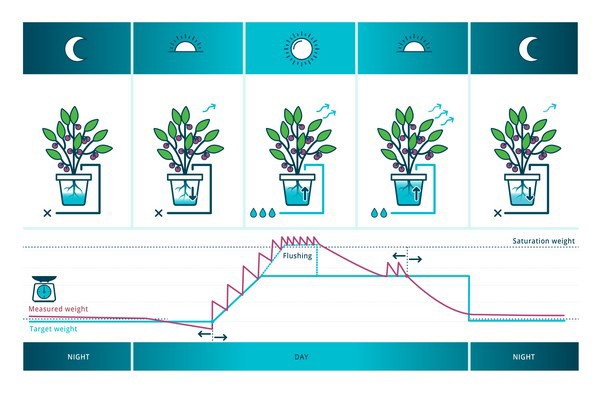Summer is nearing its end and fall is approaching. This means shorter days, lower temperatures, and a change in the rhythm of life. And it’s no different for your crop: it will be transpiring less and its water requirements will decrease. These factors must be taken into account so that the crop and its root system stay healthy and you maintain the quality of the final harvesting cycles going into fall. Kevin de Kok, consultant at Priva, gives some practical tips on how to better control crop transpiration as the weather changes.
Transpiration: why is it so important?
As the seasons change, for example from summer to fall, it’s important to keep a close eye on the temperature in the greenhouse and transpiration from the crop. If temperatures get too low, the plants stop evaporating and as a result also water absorption. This in turn will severely impact the quality of the harvest. Why is that? Evaporation creates a lack of water in the plant, which it compensates for by taking up more. This flow of water also supplies the plant with nutrients from the substrate. If the plant stops transpiring, it will therefore also stop taking up nutrients.
Better control of transpiration from your crop
Tip 1: Avoid a sudden change in temperature
In August and September, the temperature can drop significantly at night. A sudden drop in temperature can negatively affect plant quality. You can make sure the temperature in the greenhouse falls gradually by making a simple adjustment to the settings of your energy screens. By closing them earlier, you will retain the heat in the greenhouse and keep the cold out, thus avoiding a sudden drop in temperature. Closing the energy screens too late may mean that you have to heat the greenhouse again.
Tip 2: Reduce watering earlier
With the shorter days and lower temperatures, the water requirements of your crop will also reduce. It is important to adjust your irrigation so that the substrate doesn’t become too wet. Overly wet substrate can lead to anaerobic conditions which can cause the roots to die. To be able to determine your crop’s water requirements, it’s therefore useful to gain insight into its natural rhythm. During the day the crop is active, so it loses a lot of water through transpiration, while at night it is in a state of rest and takes up virtually no water. With the help of scales, you can determine how much the crop is transpiring, as the difference in weight will indicate how much water the plant has lost. This will tell you if the crop is getting too much water and if you should reduce watering earlier.

You can of course adjust your irrigation settings manually, but there are also ways of automating this. There is an additional module available for the Priva process computer, the Moisture Balance Module, which automatically adjusts the dosage and timing of water and fertilizers to the crop’s water consumption. This will allow you to irrigate your crop more accurately.
For more information:
Priva
www.priva.com
contact.priva@priva.nl
